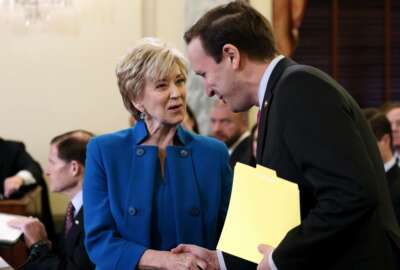
House committee lays out priorities to ensure ‘real results’ for small businesses
The House Small Business Committee says it will be focusing this fiscal year on program oversight, improved management, and reducing duplicative efforts.
The House Small Business Committee this week approved its fiscal 2018 Views and Estimates, a guideline for the upcoming congressional session and budget process that focuses on improved services for the small business community.
Among the committee’s priorities are oversight of certain programs, redirecting resources, and eliminating redundancies. The initiatives and programs often are duplicative of “longstanding small business outreach efforts,” are not reviewed, approved by the committee, nor are they properly assessed by SBA.
“I am confident that the overwhelming, bipartisan consensus of the Small Business Committee on these priorities, along with the new leadership at the Small Business Administration and at the White House, America’s 28 million small businesses will soon see their government step out of their way and allow them to do what they do best: create good jobs,” said Rep. Steve Chabot (R-Ohio) in a statement.
An SBA spokeswoman said the agency was still reviewing the report.
The SBA’s four major capital access programs are: the SBA Advantage Loan Program [formerly the 7(a) Guaranteed Loan Program]; the Grow Loans Program [formerly the Certified Development Company Loan Program]; the Small Business Investment Company Program; and the Microloan Program.
“The SBA must ensure that it can provide proper oversight of its capital access programs so that the underlying public policy goals are met,” the committee said. “This means that SBA must develop regulatory standards by which it can measure its compliance with these goals and ensure that its capital access partners are in compliance. SBA must improve its oversight of lending program participants. The SBA OIG identified the SBA’s failure to provide effective lender oversight as one of the most serious facing the agency.”
The committee said the latter two programs were wise investments and financially sound, however, the Advantage Program and Grow Loans Program raised red flags for the committee.
Both of those programs are designed to work without federal subsidies, the committee reported, but if SBA does need subsidies to run the programs, “the rationale has been that because small businesses create much needed jobs, it would be counterproductive to increase the cost of making loans to them.”
“In 2015, SBA’s Advantage Program experienced unprecedented demand and reached its $18.75 billion authorized loan limit,” the committee said. “Unfortunately, SBA did not inform Congress until the lending ceiling was reached, and lending was temporarily delayed until Congress took emergency action. In legislation to raise the lending level to $23.5 billion, Congress required SBA to regularly report on loan levels so in the future, emergency action will not be needed. The committee believes that the current authorization level of $28.5 billion should be sufficient for some time.”
The committee said it plans to provide “aggressive oversight” of the Advantage Program.
The Grow Loans Program is also under committee scrutiny because of what it says is a risk to taxpayers, and a fear that refinancing existing debt isn’t the best way to promote economic development.
“In previous years, SBA has repeatedly requested annual reauthorization of the program so the Grow Loan Program could refinance $7.5 billion in commercial real estate loans, using the rationale that the program would receive sufficient fees to operate at zero subsidy,” the committee said. “The committee would not support any allocation of funds for commercial refinancing of existing debt until the Grow Loan Program is reformed to protect taxpayers from a downturn in the value of commercial real estate.”
When it comes to entrepreneurial development programs, the committee has its eye on the Small Business Development Center (SBDC) Program, the SCORE Program, and the Women’s Business Center program.
The SBDC Program is “an important time-tested program on which small businesses depend,” the committee said. “In past years, the committee has said it believes SBA undervalues the SBDC Program, and has supported a small increase of funds to be reallocated from SBA-created initiatives to the SBDC Program.”
The SCORE Program provides face-to-face counseling, and the committee also supports that initiative.
The Women’s Business Center Program was originally created to function using private funds, and focus on helping women in underserved areas. However, over time the program has been relying on federal dollars, the centers end up in areas already served by the SBDC Program, and about 25 percent of clients are male.
“During this Congress, the committee may consider legislation to make improvements to the WBC Program,” the committee said. “As the committee has stated, federal tax dollars are not used wisely when SBA creates initiatives that duplicate programs already in operation at SBA or other agencies. Nevertheless, SBA programmatic duplication exists and is exacerbated by SBA’s failure to measure the effectiveness of these programs.”
The committee said in its report that it plans to hold HUBzone Program oversight hearings, and in fact held a subcommittee hearing March 2 on the program and its progress.
“When the HUBZone Program was first established, its goal was to create hope for ‘hundreds of thousands of underemployed or unemployed who long ago thought our country had given up on them,'” said subcommittee Chairman Steve Knight (R-Calif.) “I can think of no more important goal than bringing economic hope, independence, jobs, and businesses to neglected areas marked by high unemployment and poverty. To achieve this objective, the HUBZone Program must be run efficiently and effectively. That requires us to take a hard look backwards and learn from the past.”
Since 2011 the Government Accountability Office has made 11 recommendations for the program, seven of which SBA has implemented, such as putting in place procedures for reporting fraud, updating maps used for the program, and establishing time frames for cutting down on recertification backlogs.
SBA is also looking at improved IT management at SBA, as well as streamlining of SBA headquarters.
“As the committee has mentioned before, this includes an amorphous Office of Policy and a personal Office of the Administrator that includes approximately the same number of personnel as the Secretary of Defense and the Secretary of Agriculture,” the report stated. “The committee believes this is unacceptable, and recommends a 10 percent reduction in funds for the Office of the Administrator.”
The committee also warned in its report that while past funding levels for SBA’s disaster loan programs have been sufficient —SBA requested $185 million in 2017 — an emergency supplemental appropriation is needed if the agency wants to cover a serious disaster in 2018.
Agencies are currently in the “passback” phase of the federal budget process. The Office of Management and Budget sent topline numbers to agencies, who are reviewing those figures and how they will adjust their spending plans to meet the administration’s financial directives.
Copyright © 2025 Federal News Network. All rights reserved. This website is not intended for users located within the European Economic Area.





